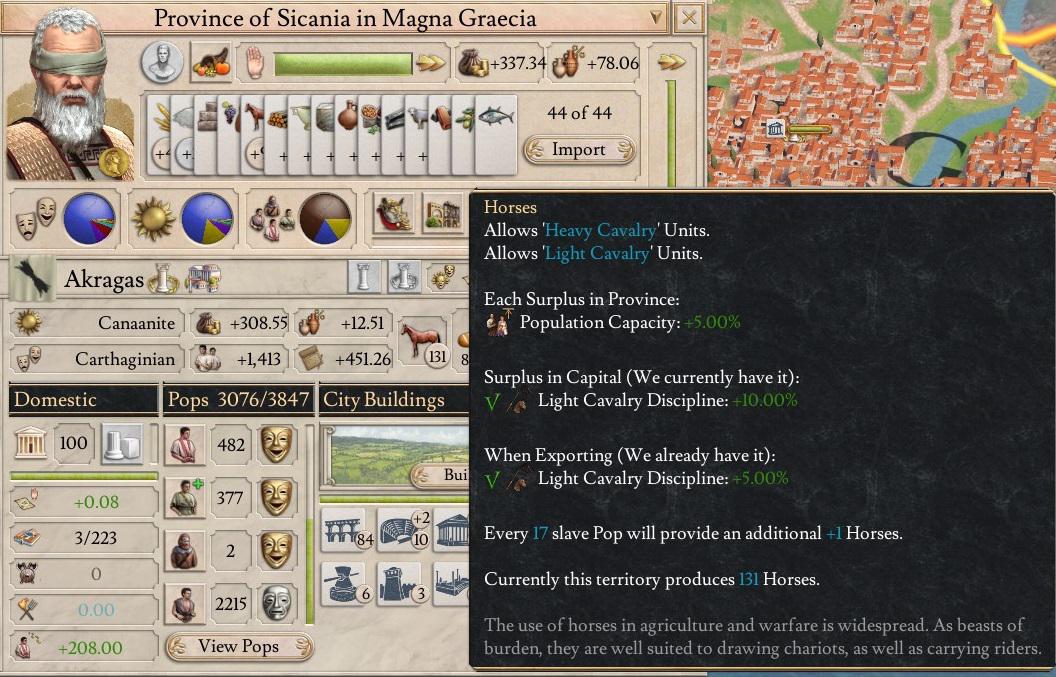
Ancient Rome had a population of about one million people at its height, but due to a balance oversight in classical grand strategy sandbox Imperator: Rome, redditor Vingsii has found a way to make that look like a quaint little village. And it involves horses. Lots and lots and lots of horses.
“Planning your tall little empire around Akragas in Sicily is quite good I've found,” he writes nonchalantly, very much underselling the madness he’s about to explain. “So as you can see on the screen above, 130+ horses produced for a solid 3,8k capacity, while breaking just above 3k.” While population units (pops) don’t translate to an exact number of simulated humans, that number lets us ballpark the size of his polis at around three million people (about the same as modern day Chicago) with the capacity to feed almost a million more.

In the recent 1.2 patch, Imperator switched from treating every territory the same to distinguishing between cities, which have lots of people in them and mostly produce specialty goods, and settlements, which are rural areas that have lower population and produce food and other simple goods. The amount of goods produced in a territory is based on the population, and theoretically, this duality should make it impossible to create an overpowered feedback loop. Cities can’t grow grain with their bustling multitudes of toga-clad urbanites, and settlements can’t get big enough to support exponential growth of their food output. They’re supposed to exist in a kind of balanced symbiosis where the countryside feeds the urban centers.
But that’s where horses come galloping in.
See, horses are treated as a military resource in Imperator, not an agricultural one. That means if you plop down a city on what was once equestrian pastureland, that city can go right on ahead breeding horses as its main industry. However, horses act kind of like an agricultural product in that they increase the population capacity of the territory they’re in. I guess the assumption is that you could dine on horse meat if better fare wasn’t available. But maybe you see where the issue with this is?
Effectively, you can create a city that produces horses, which raise the population cap, which lets you bring in more laborers to breed more horses, which raises the population cap further, and so on. Effectively, you’ve created a manure-smelling, marble-clad arcology with millions of inhabitants breeding horses in urban workshops on an industrial scale, before grinding them up into burgers to feed the teeming masses. You’ve effectively broken the game and can make a single, self-sufficient equine settlement that rivals even modern metroplexes.
This sort of oversight is likely to be patched out in the future, but it’s pretty hilarious for the time being. And it’s well in keeping with Paradox Development Studio’s long tradition of horse-related shenanigans.
Keep up to date with the most important stories and the best deals, as picked by the PC Gamer team.
Len Hafer is a freelancer and lifelong PC gamer with a specialty in strategy, RPGs, horror, and survival games. A chance encounter with Warcraft 2: Tides of Darkness changed her life forever. Today, her favorites include the grand strategy games from Paradox Interactive like Crusader Kings and Europa Universalis, and thought-provoking, story-rich RPGs like Persona 5 and Disco Elysium. She also loves history, hiking in the mountains of Colorado, and heavy metal music.

